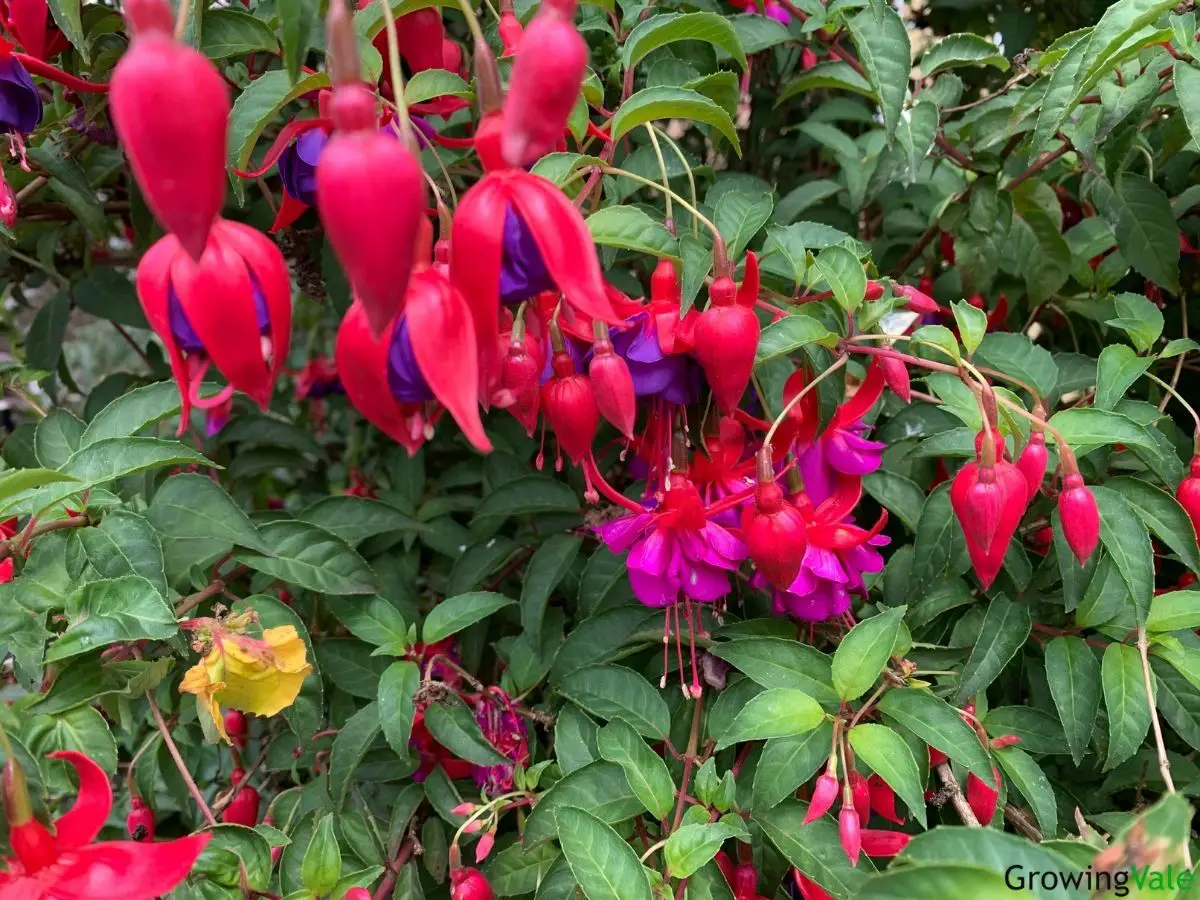Fuchsias (sometimes misspelled as fuschia) are a group of flowering trees and shrubs that belong to the Evening Primrose family (Onagraceae). The genus Fuchsia contains over 100 species, several of which are garden favorites. They are grown as perennial shrubs in milder climates but are also grown in containers and hanging baskets. In colder climates, they should either be overwintered indoors or grown as annuals.
These beautiful plants are prized for their ornate and delicate flowers. Perfect for the shadier areas in the garden, they make great bedding shrubs or container plants in patios. Their pendulum blooms lend them particularly to Japanese or Chinese-inspired gardens, but these magnificent flowers would brighten up any outdoor space!
History
Fuchsia plants are native to tropical and subtropical areas of Central and South America, New Zealand, and Tahiti. First discovered in the Dominican Republic in the late 1600s by Father Charles Plumier, a missionary, and botanist, he named the first Fuchsia species Fuchsia triphylla coccinea after a German botanist Leonard Fuchs, who had passed away 100 years prior.
Today Fuchsia triphylla coccinea is simply known as F. triphylla. While the species was named after a person, the color Fuchsia, a vivid purple-red shade, was named after the genus! Fuchsia flowers are also commonly known as Ladies’ Eardrop, due to their hanging nature and shape resembling an earring.
Since their discovery, Fuschia shrubs have been extremely sought-after, reaching the height of their popularity in the Victorian Era, when these delightful plants lined driveways and adorned pillars of large estates. This favor has led to the estimated 3000-5000 varieties and cultivars we have today!
Garden Fuchsia varieties usually grow between 2 – 10 feet tall, however, tree types such as F. excorticata, a New Zealand native, can reach up to 50 feet tall. These plants can be trained as hedges and topiary standards, and flowers come in single or double form, and come in red, pink, white, violet, or purple, or a combination of these.
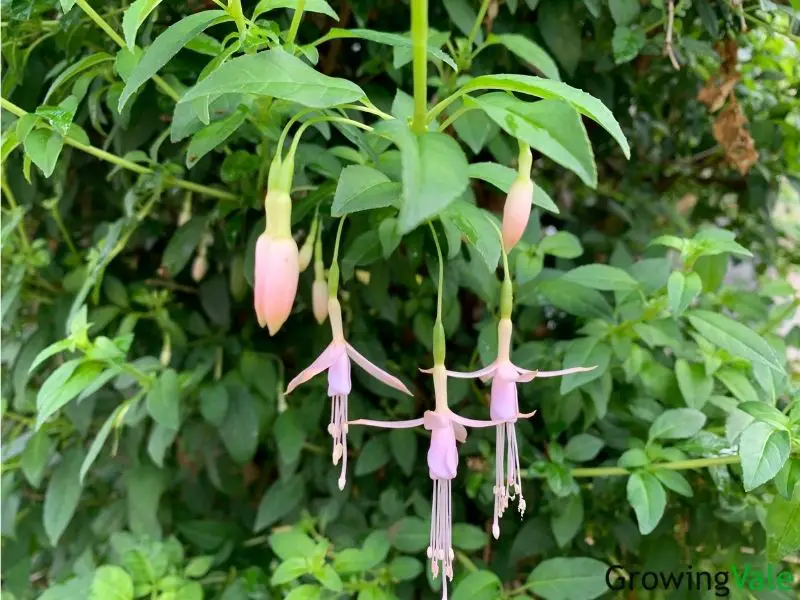
Plant Facts
| Scientific name | Fuchsia spp. |
| Common names | Fuchsia, Ladies’ Eardrop, Hardy Fuchsia, Tender Fuchsia |
| Genus | Fuchsia |
| Family | Onagraceae |
| Height | 1 ft. 0 in. – 10 ft. 0 in. |
| Width | 1 ft. 0 in. – 6 ft. 0 in. |
| USDA Plant Hardiness Zone | 7a, 7b, 8a, 8b, 9a, 9b, 10a, 10b, 11a, 11b |
| Origin | Central and South America, New Zealand, Tahiti |
| Flower colors | Pink, Red, Violet, Purple, White |
| Blooming season | Summer, Fall |
| Plant/Flower special features | Ornate, pendulum flowers |
How to Plant and Grow Fuchsia Shrubs
Fuchsia plants are classified as either “hardy” or “tender”. When planting it is important to know what types of fuchsia you have, as care and maintenance needs will differ slightly.
Plant or place tender Fuchsias outside in mid-late spring once the threat of frost has passed. Hardy types should be planted in early to late summer – those planted in late summer will need extra watering to help with their establishment in the hot, dry weather.
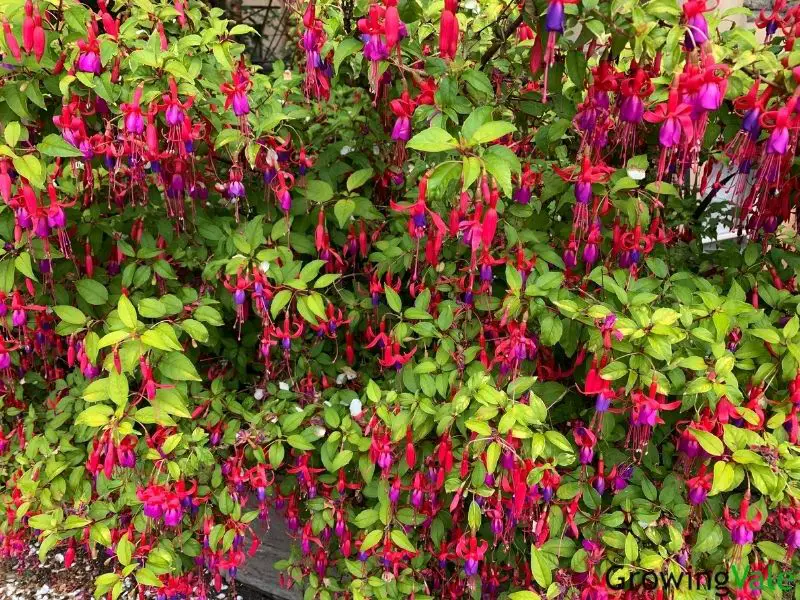
Growing Fuchsia Flowers in Beds
For Fuchsia shrubs, first, soak the potted shrub thoroughly, then dig a hole deeper and three times as wide as the roots. Tip out and gently tease the roots, then plant with the base 2 inches below the soil line. Refill the hole and press the soil down firmly. Mulch around the base of the shrub and water well.
Growing Fuchsia Flowers in Pots
For container and hanging basket planting, use a peat-free multipurpose potting mix. Make a hole large enough to house the roots and gently place the plant inside. Cover with soil and firmly press down. Water well to settle in.
Overwintering Fuchsias
Tender Fuchsias need to be overwintered in a frost-free environment, such as inside on a windowsill, a greenhouse, or a conservatory. Pots can easily be carried indoors, but for those planted in the ground, they should be lifted, potted, and stored inside.
Trim back plants to leave 3-6 inch stems, this is where new shoots will grow the following year. Stems can be left longer for a bigger display, but the base of the plant will be woody and brown.
For topiary standard Fuchsia trees, both hardy and tender types will need overwintering indoors as the main stem is vulnerable to frost. Trim back growth to 3-6 inches from the top of the trunk before bringing indoors.
Water overwintered plants to keep the soil barely moist and expect new shoots within a few weeks. Pinch back new growth to encourage branching.
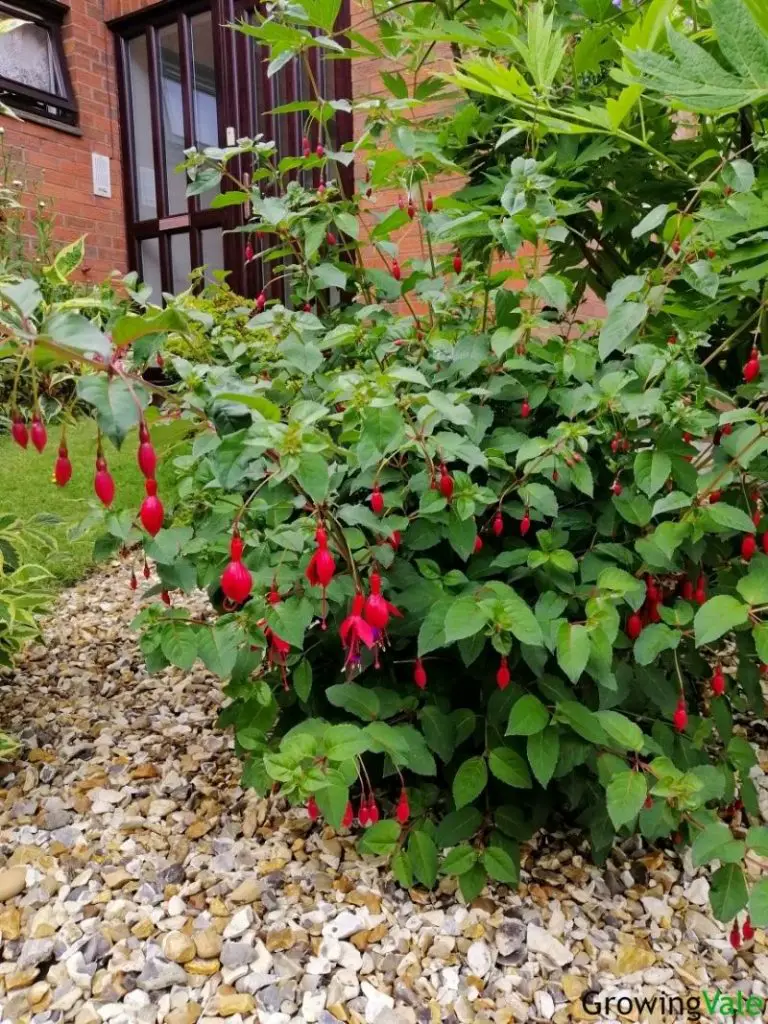
How to Propagate Fuchsia Plants
Fuchsias easily propagated either from seeds or cuttings. Depending on Fuschia type (hardy or tender), the recommended propagation method varies. Keep in mind that those grown from seeds may not be true to the parent plant.
Propagation From Cuttings
For tender Fuchsia bush propagation, take 6-inch softwood cuttings (new, green shoots) at any time during the year, leaving the two to three uppermost leaves. Either put cuttings straight into a well-draining rooting medium or put them to root in a glass of water, in a bright area away from direct sunlight.
Those grown in rooting compost should root within 10-20 days. With cuttings rooting the fastest in spring or summer. For water rooted cuttings, wait until roots have reached 1 inch long before planting them in small individual pots of peat-free multipurpose compost.
To propagate hardy Fuchsia trees from cuttings, take 6-inch hard-wood cuttings (brown with woody bark) in late autumn. Place the cuttings halfway into a pot of peat-free cutting compost, spacing them out evenly. Make sure to put them into the compost the right way up.
Place the container in a frost-free location at 45 to 50ºF, and keep the soil moist. By late spring, there should be new shoots and the cuttings will be ready to be transferred into individual containers. Plant them outside by early summer.
Propagation From Seeds
Prepare a tray by firmly compressing the growing medium down. Sow seeds on top, and cover with a fine layer of compost, before pressing down firmly on the soil again and misting. Keep the tray at 70-75 ºF and water lightly when the soil looks dry. The seeds should germinate in 21-28 days.
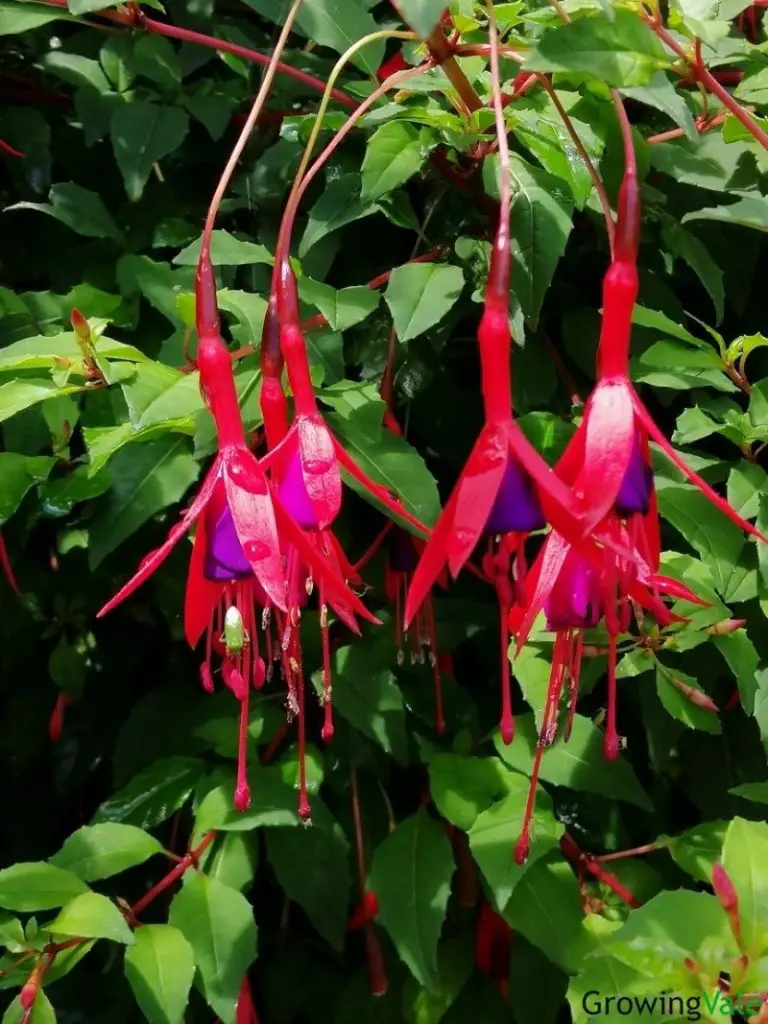
Care and Maintenance
Here are some Fuchsia care tips:
Soil
Fuchsia plants are tolerant of most soil types but do not tolerate extremes of either overly wet or overly dry soil.
Water
For tender Fuchsias, keep the soil moist but not overly wet. Those grown in containers or hanging baskets may need daily watering, whereas those in the ground may need weekly watering. By summertime, plants will require a larger volume of water, as they will be larger and more established.
Hardy types require regular watering during the spring and summer after planting while they are becoming established. After that, older, larger, and more established plants may only need to be thoroughly watered occasionally during hot summers.
Fertilizer
Both tender and hardy Fuchsia flowers that are grown in containers are heavy feeders and will benefit from a liquid fertilizer every two to four weeks during the growing season (mid May-early-September). Two weeks before they are brought indoors, stop feeding to prepare them for overwintering.
Hardy types grown in borders will require feeding once a year if growth is poor, from a general-purpose fertilizer. Mulching yearly with well-rotted manure or compost is recommended to improve the soil quality and reduce water stress.
Sunlight
Plant them in areas ranging from sunny to dappled shade, but bear in mind that too much shade will result in fewer flowers.

Temperature and Humidity
Tender Fuchsias are generally winter hardy to USDA zones 10-11, whereas hardy types are suited to zones 7-10. They prefer daytime temperatures of 60-70ºF and nights that are cooler by around 10ºF. Cool night temperatures are crucial during the early growth period, and daytime temperatures exceeding 76ºF will stop flower production.
It is only recommended to grow and train hardy Fuchsias as hedges in areas that experience mild winters. In colder regions, they will be killed down to the ground during winter, although they will regrow the following year.
Pest and diseases
The most common Fuchsia plant pest is whiteflies, but aphids, thrips, mealybugs, spider mites, Fuchsia flea beetles, and scales are also things to watch out for. They can also be affected by vine weevil grubs which will attack the roots. Before bringing plants indoors for overwintering, scout and remove any insect pests.
Fuchsias can suffer from Botrytis blight, so it is important to space them out while planting to promote good air circulation. Fuchsia rust can also be a problem, however, some cultivars have resistance.
Pruning
Pinch back new growth to promote branching and increase the potential number of flowers. This delays flowering by up to 8 weeks, so pinching out early during late winter and spring is recommended.
For hardy Fuchsia shrubs and hedges, lightly prune in early spring to neaten them up after the winter (all plants will have a little dieback in the cold), which can leave plants looking a little disheveled. Remove any dead growth back to live shoots, and cut forming buds down to the stem.
For hardy types that still could not withstand the cold winter temperatures, cut all of the previous year’s dead growth back to the ground in early spring to allow for new growth. Make sure not to damage any new shoots.
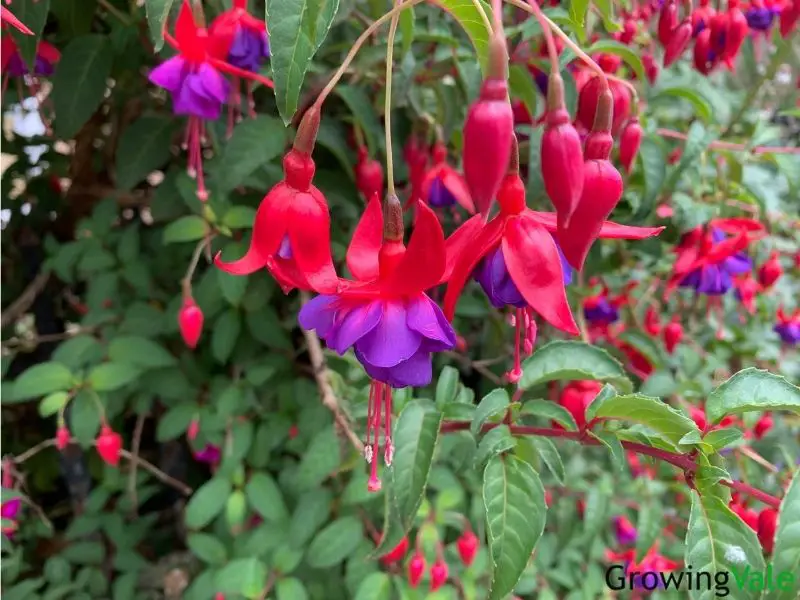
Uses of Fuchsias
Fuchsias are extremely popular ornamental plants. They are grown in pots or hanging baskets, make great hedges for borders, and can be trained as standards.
All species and cultivars bear edible, deep purple to blackberries, however, the taste and quality of fruits are hit or miss. Fruits are sometimes tasteless, tart, or have a bad aftertaste. The best way to consume them is as a jam where the sugar can bring out their flavor, although they can be enjoyed in salads and baked into muffins.
Common Fuchsia Varieties and Cultivars
Here are some of the most popular Fuchsia types, varieties and cultivars, including hardy and hybrid fuchsia:
- (F. magellanica var. molinae) Maiden’s Blush – First introduced in 1929, this hardy Fuchsia has slender blooms which have narrow white sepals and pale lilac-pink petals.
- (Fuchsia glazioviana) Glaziou’s Fuchsia – Native to South Brazil, this fast-growing Fuchsia flower has slender blooms, with deep pink sepals and purple petals.
- (Hybrid) Ballet Girl – Award-winning Ballet girl (Award of Garden Merit from the Royal Horticultural Society) has medium to large, double blooms. Petals are white with delicate pale pink veining. Sepals curl upwards and are raspberry pink.
- (Hybrid) Delta’s Sara – Delta’s Sara is a stunning Fuchsia cultivar with medium, double flowers. Slender, white sepals curve upwards, showcasing the lovely violet-blue petals.
- (Hybrid) Genii – A winner of the Award of Garden Merit from the Royal Horticultural Society, This hardy Fuchsia has small to medium flowers, with curling deep pink sepals, and purple petals.
Conclusion
Fuchsias are beautiful and ornate plants that belong to the Evening Primrose family. Part of a genus of over 100 species and an estimated 3000-5000 types and varieties, these plants were at the height of their popularity in the Victorian Era.
Still immensely popular today, they are grown as outdoor annuals, overwintered container plants, or perennial shrubs in mild climates. Depending on the variety, they can be used for pots, hanging baskets, shrubs, bushes, hedges, and even trained as topiary standards.
They are relatively low-maintenance plants that aren’t fussy about soil type, don’t require heavy pruning, and are easily propagated from stem cuttings. Their berries are even edible and can be made into jam, sprinkled on salads, or baked into muffins. But beware, as taste and quality aren’t consistent so trying the fruits first is recommended!
Fuchsias have many beautiful and colorful species, varieties, and cultivars. Their pendulum blooms would easily suit Japanese or Chinese-inspired gardens, but their bold flowers and long blooming time make them fantastic choices for any outdoor space.

